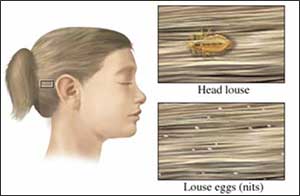
Head lice are small insects that feed on blood found on the human scalp. They are most often found on the scalp, behind the ears, and near the neckline at the back of the neck. Head lice also may live in the eyebrows, eyelashes, and beard. The lice hold onto hair with the hook-like claws they have at the ends of each of their six legs. Lice move by crawling, not hopping or flying, and are spread by personal contact and sharing combs, brushes, hats, and other personal items.
In the United States, there are approximately 6-12 million cases of head lice each year in children ages 3 to 11. While head lice are an annoyance, they are not known to spread disease. According to the American Academy of Pediatrics, it is not necessary for a child to miss school due to head lice. The child can finish the school day, go home and receive treatment, and return the next day. Each school district may have its own policy, however, so check with the school nurse before sending your child to school.
Head Lice

Copyright© Nucleus Medical Media, Inc.
Risk Factors
This condition is most common in preschool and elementary school children, and their families are at the greatest risk of exposure to head lice. Girls get head lice more often than boys and women more than men. Factors that may increase the chance of lice include:
- Sharing combs, brushes, hats, and other personal items
- Personal contact with people who may have lice
Signs and Symptoms
Some people with head lice do not have any symptoms. When symptoms do occur, these signs are a good indication:
- Feeling of tickling or crawling in hair
- Itching or scratching
- Irritability, especially at night
- Sores on the head due to scratching
- Eggs or lice seen in the hair or on the scalp
Diagnosis and Treatment
When you find head lice, spring into action as quickly as you can. The first priority should be to get rid of lice eggs, called nits, in order to end the life cycle. Your physician will ask about your symptoms and medical history. A physical exam will be done, and your head and scalp will be examined for lice and lice eggs (nits). Do not self-diagnose and self-treat head lice. Some treatments can cause irritation and should only be used by people who have the infestation.
Treating head lice involves removing eggs and killing lice so that they cannot continue to lay eggs. Treatment may be difficult and, in some regions, lice have become resistant to many commonly used medications. Some experts recommend that treatment be given only when live adult lice are seen.
Methods include:
Over-the-Counter Medication
Most cases of head lice can be treated with over-the-counter preparations, including shampoo containing the insecticide permethrin. It is important to use medications as directed. Retreatment at 7-10 days is usually required to kill any lice that hatch from unremoved eggs.
Prescription Medication
Prescription creams or lotions may be prescribed to treat head lice. Be sure to follow the instructions carefully, as some treatments can have serious side effects.
Use a Fine-Toothed Comb
A fine-toothed comb designed to capture and remove the lice and nits often comes with medicated shampoos and lotions. The teeth of the comb should be long and tapered and set so close that combing removes virtually all lice and nits. This comb can also be used to check for lice after treatment. Removing lice on the eyelashes may be difficult. Tweezers can be used to pick them off and petroleum jelly may be used to coat the eyelashes and kill the lice.
Wash Household Items
Wash all bedding and clothing in hot water and dry them in a dryer using high heat. Vacuum floors, beds, chairs, car seats, and headrests—any place that the person with lice has been. Soak combs and brushes in hot water for 5-10 minutes. Items that cannot be washed, such as stuffed animals, can be sealed in a plastic bag for 2 weeks.
Keep Checking
Some people report that despite vigilance and treatment, the lice keep coming back. Be sure to continue checking for lice regularly. If the treatment did not work, let your doctor know as another medication may need to be used. As much as no one wants to reveal that they have head lice, it is important to warn friends who may have been exposed. After spending weeks to eliminate the lice, you do not want your child to pick it up all over again.
Tips for Preventing Head Lice
Lice are common, especially in children. To prevent outbreaks of head lice:
- Watch for signs of head lice, such as frequent head scratching.
- Do not share combs, brushes, hats, hair accessories, or other personal items with people who may have lice.
- Avoid close personal contact with people who may have lice.
- If you or your children have head lice, thoroughly wash and dry combs, brushes, hats, clothing, bedding, and stuffed animals. Also, vacuum carpeting and car seats.
- If your children get head lice, notify their school, camp, daycare provider, and their friends' parents.
- Check all family members for lice and eggs at least once a week.
Sources:
Dr. Elliot Freed is available to provide more information on the symptoms, diagnosis, and treatment of lice. You can schedule an appointment by calling the office at (540) 626-4343 or book an appointment online below.